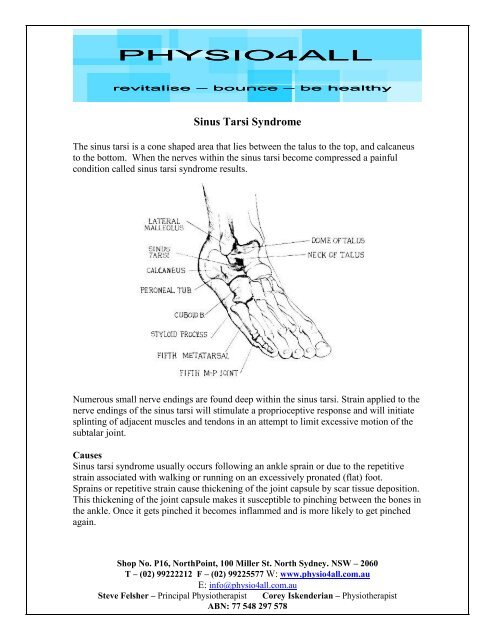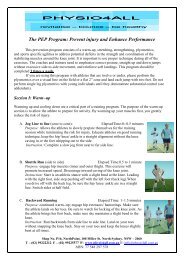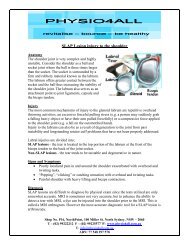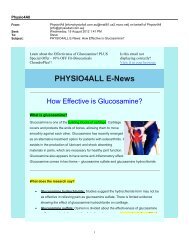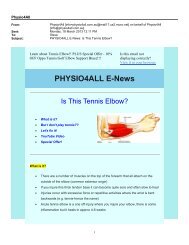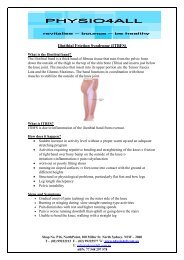Sinus Tarsi Syndrome.pdf - PHYSIO4All
Sinus Tarsi Syndrome.pdf - PHYSIO4All
Sinus Tarsi Syndrome.pdf - PHYSIO4All
Create successful ePaper yourself
Turn your PDF publications into a flip-book with our unique Google optimized e-Paper software.
PHYSIO4ALLrevitalise – bounce – be healthy<strong>Sinus</strong> <strong>Tarsi</strong> <strong>Syndrome</strong>The sinus tarsi is a cone shaped area that lies between the talus to the top, and calcaneusto the bottom. When the nerves within the sinus tarsi become compressed a painfulcondition called sinus tarsi syndrome results.Numerous small nerve endings are found deep within the sinus tarsi. Strain applied to thenerve endings of the sinus tarsi will stimulate a proprioceptive response and will initiatesplinting of adjacent muscles and tendons in an attempt to limit excessive motion of thesubtalar joint.Causes<strong>Sinus</strong> tarsi syndrome usually occurs following an ankle sprain or due to the repetitivestrain associated with walking or running on an excessively pronated (flat) foot.Sprains or repetitive strain cause thickening of the joint capsule by scar tissue deposition.This thickening of the joint capsule makes it susceptible to pinching between the bones inthe ankle. Once it gets pinched it becomes inflammed and is more likely to get pinchedagain.Shop No. P16, NorthPoint, 100 Miller St. North Sydney. NSW – 2060T – (02) 99222212 F – (02) 99225577 W: www.physio4all.com.auE: info@physio4all.com.auSteve Felsher – Principal Physiotherapist Corey Iskenderian – PhysiotherapistABN: 77 548 297 578
PHYSIO4ALLrevitalise – bounce – be healthyBiomechanics• History of trauma to the subtalar joint, such as an ankle sprain. If an ankleinversion sprain is not treated or rehabilitated properly the ankle becomesunstable, resulting in more ankle sprains and occasionally a feeling ofunsteadiness when walking on uneven surfaces. Furthermore, the natural healingprocess of an ankle sprain may result in thickening of the joint capsule which thenpredisposes to developing a sinus tarsi syndrome.• Compression of the tissues within the sinus tarsi occurs as the foot pronates (rollsinwards). Pronation significantly increases pressure within the sinus tarsi.• Often patients who experience sinus tarsi syndrome also suffer from pathologicalflatfeet.• <strong>Sinus</strong> tarsi syndrome may also be due to chronic inflammatory conditions of thesubtalar joint. Chronic inflammatory tissue can result from arthritis or cystformation within the sinus tarsi or adjacent subtalar joint.• The onset of sinus tarsi syndrome usually occurs in the second or third decade oflife.Symptoms• Pain along the top and/or outside of the foot and ankle.• Sharp pinching sensation.• Pain reproduced when foot is dorsiflexed (toes pulled closer to shin), such aswhen walking up stairs.• Pain that increases with time on the feet.• Pain that is relieved by rest.• Patients with sinus tarsi syndrome commonly complain of hindfoot instabilitywhile walking on uneven ground• Tarsal pain that increases when the foot is forced inwards.Diagnosis• Direct palpation of the sinus tarsi.• Range of motion of the subtalar joint.• An injection of local anesthesia into the sinus tarsi is a common tool used to blockthe nerve sensation of the sinus tarsi. If pain relief is achieved following injection,the diagnosis of sinus tarsi syndrome is made.• X-rays do not provide information specific to sinus tarsi syndrome, but arenecessary to rule out fractures of the talus or calcaneus. Also, x-rays can be usedto evaluate the integrity of the subtalar joint and rule out arthritis. MRI's can beuseful in cases of sinus tarsi syndrome and can identify inflamed tissue within thecanalis tarsi.Shop No. P16, NorthPoint, 100 Miller St. North Sydney. NSW – 2060T – (02) 99222212 F – (02) 99225577 W: www.physio4all.com.auE: info@physio4all.com.auSteve Felsher – Principal Physiotherapist Corey Iskenderian – PhysiotherapistABN: 77 548 297 578
PHYSIO4ALLrevitalise – bounce – be healthyPhysiotherapy Treatment• Cryotherapy/ice• Modalities such as electrical stimulation, ice, acupuncture or ultrasound to helpreduce pain and swelling.• Deep tissue friction massage to reduce the formation of scar tissue.• Joint mobilisation• Exercise to improve flexibility, strength and balance• Possible orthotics prescription to control poor foot mechanics.• Advice on correct footwear• Ankle bracing/taping• Activity modification adviceCorticosteroid and anesthetic injection into the sinus tarsi may be appropriate to improvethe condition. If cortisone and physiotherapy prove ineffective, ablation (destruction) ofthe nerve can be accomplished by chemical or thermal means. Surgical debridement ofthe sinus tarsi can also be used to denervate the sinus tarsi. Arthroscopic methods areavailable and have proven to be successful. Open evacuation of the contents of the sinustarsi may also be performed. In severe cases of sinus tarsitis where pain does not respondto surgical evacuation of the sinus, a fusion of the subtalar joint may be indicated.Differential Diagnosis• Ankle sprain• Calcaneal fracture• Impingement within the ankle• Intermediate dorsal cutaneous nerve entrapment• Talar fractureShop No. P16, NorthPoint, 100 Miller St. North Sydney. NSW – 2060T – (02) 99222212 F – (02) 99225577 W: www.physio4all.com.auE: info@physio4all.com.auSteve Felsher – Principal Physiotherapist Corey Iskenderian – PhysiotherapistABN: 77 548 297 578


